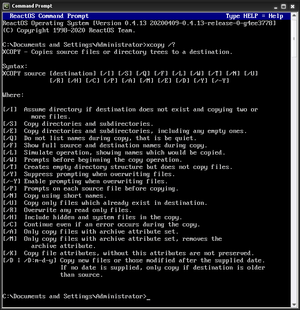XCOPY
In computing, XCOPY is a command used on IBM PC DOS, MS-DOS, IBM OS/2,[1] Microsoft Windows,[2] FreeDOS,[3] ReactOS,[4] and related operating systems for copying multiple files or entire directory trees from one directory to another and for copying files across a network.
 The ReactOS xcopy command | |
| Developer(s) | Microsoft, IBM, DR, Datalight, Novell, Rene Ableidinger, ReactOS Contributors |
|---|---|
| Initial release | 1986, 33–34 years ago |
| Operating system | MS-DOS, PC DOS, MSX-DOS, OS/2, Windows, DR DOS, ROM-DOS, FreeDOS, ReactOS |
| Type | Command |
| License | FreeDOS: GPL ReactOS: LGPL |
| Website | docs |
Overview
XCOPY stands for extended copy,[5] and was created as a more functional file copying utility than the copy command found in earlier operating systems. XCOPY first appeared in DOS 3.2.[6]
While still included in Windows 10, XCOPY has been deprecated in favor of robocopy, a more powerful copy tool, which is now built into the Microsoft Windows Server and Desktop operating systems.[7]
DR DOS 6.0[8] and Datalight ROM-DOS[9] include an implementation of the XCOPY command.
The FreeDOS version was developed by Rene Ableidinger and is licensed under the GPL.[10]
J. Edmeades developed the Wine-compatible version that is included in ReactOS. It is licensed under the LGPL.[11]
Example
Create a new directory by copying all contents of the existing directory, including any files or subdirectories having the "hidden" or "system" attributes and empty directories.
xcopy e:\existing e:\newcopy /e /i /h
If the directory names include blank signs (spaces), the names can be put in quotation marks.
xcopy "D:\Documents and Settings\MY.USERNAME\My Documents\*" "E:\MYBACKUP\My Documents\" /D/E/C/Y
Copy entire drive in to a mapped network drive while ignoring any errors in network restartable mode.
xcopy *.* z:\Netmirror /E /V /C /F /H /Y /Z 1>out.txt 2>err.txt
Copy a single file without prompt if it is a file or a directory
cmd /c echo F | xcopy "c:\directory 1\myfile" "c:\directory 2\myfile"
Limitations
XCOPY fails with an "insufficient memory" error when the path plus filename is longer than 254 characters[12] and moving large files without the "/J" option (available only after Server 2008R2) can consume all available RAM on a system.[13]
No open files
XCOPY will not copy open files. Any process may open files for exclusive read access by withholding the FILE_SHARE_READ
https://msdn.microsoft.com/en-us/library/aa363858.aspx
The Windows Volume Shadow Copy service is used for such situations, but XCOPY does not use it. Therefore, XCOPY is not useful for backing up live operating system volumes.
XCOPY deployment
XCOPY deployment or xcopy installation is a software application's installation into a Microsoft Windows system simply by copying files. The name is derived from the XCOPY command line facility provided by Microsoft operating systems.
In contrast, the installation of a typical Windows application will require a significant number of additional steps before the application is ready to be used. Most of this additional work involves, directly or indirectly, adding or modifying entries in the Windows Registry. Even when an application uses ordinary files for its own data, many common facilities provided by Windows require some type of registration step before they are available to programs. Usually, one or more specialized tools (such as Windows Installer, InnoSetup, or NSIS) are used to help coordinate these relatively complex operations.
See also
References
- http://www.jatomes.com/Help/Os2Cmd.php#XCOPY
- Xcopy
- http://freedos-project.blogspot.com/2018/06/freedos-commands-quick-reference.html
- https://github.com/reactos/reactos/tree/master/base/applications/cmdutils/xcopy
- "Windows NT File System Files". Microsoft Help and Support. Microsoft. 2006-11-01.
- Wolverton, Van (2003). Running MS-DOS Version 6.22 (20th Anniversary Edition), 6th Revised edition. Microsoft Press. ISBN 0-7356-1812-7.
- Pietrek, Matt (2007-01-16). "Robocopy built into Vista". Under The Hood (an MSDN blog).
- DR DOS 6.0 User Guide Optimisation and Configuration Tips
- "Datalight ROM-DOS User's Guide" (PDF). www.datalight.com.
- http://www.ibiblio.org/pub/micro/pc-stuff/freedos/files/distributions/1.2/repos/pkg-html/xcopy.html
- https://github.com/reactos/reactos/blob/master/base/applications/cmdutils/xcopy/xcopy.c
- Maciak, Luke (2007-02-05). "Xcopy: Insufficient Memory".
- "Technet: Xcopy". 2014-03-07.
Further reading
- Cooper, Jim (2001). Special Edition Using MS-DOS 6.22, Third Edition. Que Publishing. ISBN 978-0789725738.
- Kathy Ivens; Brian Proffit (1993). OS/2 Inside & Out. Osborne McGraw-Hill. ISBN 978-0078818714.
- John Paul Mueller (2007). Windows Administration at the Command Line for Windows Vista, Windows 2003, Windows XP, and Windows 2000. John Wiley & Sons. ISBN 978-0470165799.
External links
| Wikibooks has a book on the topic of: Guide to Windows Commands |
- xcopy | Microsoft Docs
- Switches That You Can Use with Xcopy and Xcopy32 Commands, Windows 95, Windows 98, Windows Me
- Xcopy, Microsoft Windows XP
- VariableGHz article depicting CRC errors and XCOPY as a solution
- XCOPY Command in a post build event does not execute
- XP_CMDSHELL Does Not Work with XCOPY
- See also Microsoft Product Documentation
- How to deploy an ASP.NET Web application using Xcopy deployment
- .NET Development: Determining When to Use Windows Installer Versus XCOPY
- Visual C++ How to: Deploy using XCopy